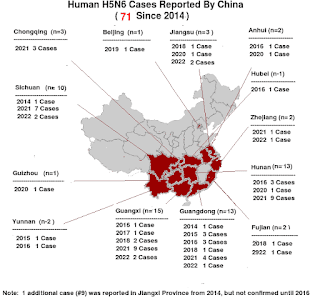#16,606
China continues to belatedly report human cases of HPAI H5N6, adding two more cases with onsets on or before end of last month. This makes 9 new cases reported between January 1st and the 31st, 2022, and a total 71 cases since the virus first emerged in 2014 (see map above).
Three of the 4 cases announced today are listed in critical condition, while the 4th died. Although human infection with H5N6 is relatively rare, it usually results in serious, often fatal, illness.
Until a little over a year ago, China was averaging fewer than 5 cases a year. Over the past 14 months the Mainland has reported 46 new cases. Given the delays in reporting, there may be others in the queue we've yet to hear about.
CHP closely monitors four human cases of avian influenza A(H5N6) in Mainland
The Centre for Health Protection (CHP) of the Department of Health is today (February 28) closely monitoring four human cases of avian influenza A(H5N6) in the Mainland, and again urged the public to maintain strict personal, food and environmental hygiene both locally and during travel.
Details of the cases are listed in the table below:
From 2014 to date, 71 human cases of avian influenza A(H5N6) have been reported by Mainland health authorities.
"All novel influenza A infections, including H5N6, are notifiable infectious diseases in Hong Kong," a spokesman for the CHP said.
Travellers to the Mainland or other affected areas must avoid visiting wet markets, live poultry markets or farms. They should be alert to the presence of backyard poultry when visiting relatives and friends. They should also avoid purchasing live or freshly slaughtered poultry, and avoid touching poultry/birds or their droppings. They should strictly observe personal and hand hygiene when visiting any place with live poultry.
Travellers returning from affected areas should consult a doctor promptly if symptoms develop, and inform the doctor of their travel history for prompt diagnosis and treatment of potential diseases. It is essential to tell the doctor if they have seen any live poultry during travel, which may imply possible exposure to contaminated environments. This will enable the doctor to assess the possibility of avian influenza and arrange necessary investigations and appropriate treatment in a timely manner.
While local surveillance, prevention and control measures are in place, the CHP will remain vigilant and work closely with the World Health Organization and relevant health authorities to monitor the latest developments.
The public should maintain strict personal, hand, food and environmental hygiene and take heed of the advice below when handling poultry:The public may visit the CHP's pages for more information: the avian influenza page, the weekly Avian Influenza Report, global statistics and affected areas of avian influenza, the Facebook Page and the YouTube Channel.
- Avoid touching poultry, birds, animals or their droppings;
- When buying live chickens, do not touch them and their droppings. Do not blow at their bottoms. Wash eggs with detergent if soiled with faecal matter and cook and consume the eggs immediately. Always wash hands thoroughly with soap and water after handling chickens and eggs;
- Eggs should be cooked well until the white and yolk become firm. Do not eat raw eggs or dip cooked food into any sauce with raw eggs. Poultry should be cooked thoroughly. If there is pinkish juice running from the cooked poultry or the middle part of its bone is still red, the poultry should be cooked again until fully done;
- Wash hands frequently, especially before touching the mouth, nose or eyes, before handling food or eating, and after going to the toilet, touching public installations or equipment such as escalator handrails, elevator control panels or door knobs, or when hands are dirtied by respiratory secretions after coughing or sneezing; and
- Wear a mask if fever or respiratory symptoms develop, when going to a hospital or clinic, or while taking care of patients with fever or respiratory symptoms.
Ends/Monday, February 28, 2022
Issued at HKT 18:52
So far, avian influenza remains primarily a threat to those who have direct contact with infected birds. And it should be also be noted that the HPAI H5N1 clade 2.3.4.4b virus currently circulating in wild birds in North America has never been linked to severe illness.
CDC Adds A New H5N6 Avian Flu Virus To IRAT List
WHO: Assessment of Risk Associated with Influenza A(H5N6) Virus
UK HSA Risk Assessment On HPAI H5N6
But, as we saw in PLoS Path: H9N2 Virus-derived M1 Protein Promotes H5N6 Virus Release in Mammalian Cells these HPAI H5 viruses continue to evolve, making them a genuine concern.
Which is why we watch events in China intently, looking for any signs this virus has acquired new abilities to transmit among humans.

